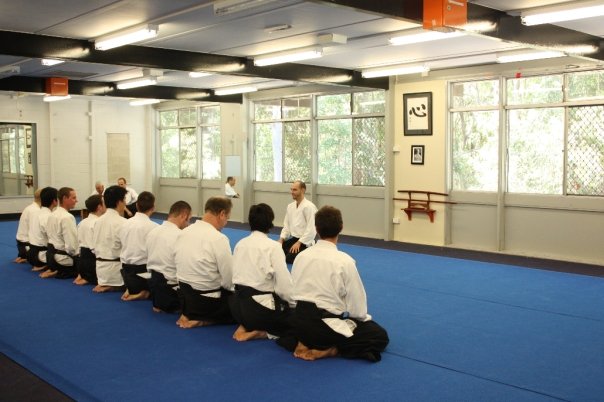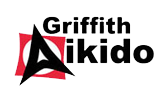Aikido etiquette and tradition
 The moment you bow into our dojo you enter a different world with its own set of rules. It is no longer your everyday world of home, business, problems and stress.
The moment you bow into our dojo you enter a different world with its own set of rules. It is no longer your everyday world of home, business, problems and stress.
The dojo is a place of peace, calm and cleanliness where you come to train. Aikido training is for both body and mind so the dojo is a place free of everyday life distractions.
Aikido etiquette is one of the cornerstones of proper dojo behavior. Many misunderstand the importance of the formalities of the dojo. Etiquette should not be thought of as servility or kowtow.
The customs observed before, during, and after training are designed to establish a controlled setting where dangerous techniques can be practiced safely.
So please do not dismiss dojo etiquette as a set of empty rituals performed merely out of habit. Here are 7 very important points of etiquette you should incorporate into your dojo life:
1. You are not permitted to train under the influence of alcohol or drugs, even with a hangover. It endangers everyone. Similarly, you should train if you are sick (e.g. cold or flu) or if you are injured in any way.
2. When entering or leaving the dojo, it is proper to bow in the direction of O Sensei’s picture, Kamiza, or the front of the dojo. You should also bow when entering or leaving the mat, and after Sensei has given you instruction. You should always bow to each partner when pairing up for practice and when ceasing practice. Finally, you should bow weapons onto the mat before use and off the mat after use.
3. Please leave your shoes at the door. You should never walk on the mat with anything other than bare feet. You should not change your clothes or even adjust your Gi on the mat.
4. Be early for class so that you can help put down the mats and vacuum them. If you do happen to arrive late, sit quietly in seiza on the edge of the mat until the instructor grants permission to join practice.
5. If you should have to leave the mat or dojo for any reason during class, approach the instructor and ask permission.
6. Sit quietly in seiza or cross-legged while the instructor is giving you instruction. Avoid sitting on the mat with your back to the picture of O Sensei or Kamiza and never sit with your legs stretched out. It is impolite to show the soles of your feet to the picture of O Sensei or Kamiza. Also never lean (sitting or standing) against a wall.
7. At the conclusion of class it is polite to offer to fold the instructor’s hakama. It is a mark of respect, plus a gesture of humility and thanks for the previous two hours or so of instruction, which in our dojo is provided on a volunteer basis.
Occasionally, people try to cherry pick Aikido etiquette. In other words, they will only do the things they approve of or feel comfortable with. There are some things they will not do because they consider it to be nothing more than servility.
There are many lessons to be learnt, including respect, humility and of course safe practice. So, either you learn Aikido with all of its lessons and traditions, or you don’t.
If you accept and follow only those traditions you approve of, you risk passing on your biased and very limited version of Aikido to those students coming behind you.
Looking for Aikido in Brisbane? Come train at Griffith Aikido. Check out class times at https://www.griffithaikido.com.au/class-times
See the new video of O Sensei added at https://www.griffithaikido.com.au/about/aikido
See Maruyama Sensei demonstrating the second Jo kata – Butterfly
